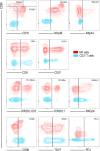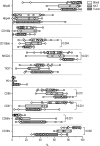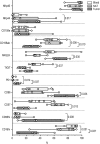Targeting natural killer cells in solid tumors
- PMID: 30911118
- PMCID: PMC6474204
- DOI: 10.1038/s41423-019-0224-2
Targeting natural killer cells in solid tumors
Abstract
Natural killer (NK) cells are innate lymphoid cells endowed with cytolytic activity and a capacity to secrete cytokines and chemokines. Several lines of evidence suggest that NK cells play an important role in anti-tumor immunity. Some therapies against hematological malignacies make use of the immune properties of NK cells, such as their ability to kill residual leukemic blasts efficiently after conditioning during haploidentical hematopoietic stem cell transplantation. However, knowledge on NK cell infiltration and the status of NK cell responsiveness in solid tumors is limited so far. The pro-angiogenic role of the recently described NK cell-like type 1 innate lymphoid cells (ILC1s) and their phenotypic resemblance to NK cells are confounding factors that add a level of complexity, at least in mice. Here, we review the current knowledge on the presence and function of NK cells in solid tumors as well as the immunotherapeutic approaches designed to harness NK cell functions in these conditions, including those that aim to reinforce conventional anti-tumor therapies to increase the chances of successful treatment.
Conflict of interest statement
G.H., P.A. and E.V. are employees of Innate Pharma. The other authors declare no competing interests.
Figures




Similar articles
-
Human natural killer cells: news in the therapy of solid tumors and high-risk leukemias.Cancer Immunol Immunother. 2016 Apr;65(4):465-76. doi: 10.1007/s00262-015-1744-y. Epub 2015 Aug 20. Cancer Immunol Immunother. 2016. PMID: 26289090 Free PMC article. Review.
-
Human NK cells: From surface receptors to clinical applications.Immunol Lett. 2016 Oct;178:15-9. doi: 10.1016/j.imlet.2016.05.007. Epub 2016 May 13. Immunol Lett. 2016. PMID: 27185471
-
Role of chemokines in the biology of natural killer cells.Curr Top Microbiol Immunol. 2010;341:37-58. doi: 10.1007/82_2010_20. Curr Top Microbiol Immunol. 2010. PMID: 20369317 Review.
-
Targeting human leukocyte antigen G with chimeric antigen receptors of natural killer cells convert immunosuppression to ablate solid tumors.J Immunother Cancer. 2021 Oct;9(10):e003050. doi: 10.1136/jitc-2021-003050. J Immunother Cancer. 2021. PMID: 34663641 Free PMC article.
-
Killer Ig-like receptor-mediated control of natural killer cell alloreactivity in haploidentical hematopoietic stem cell transplantation.Blood. 2011 Jan 20;117(3):764-71. doi: 10.1182/blood-2010-08-264085. Epub 2010 Oct 1. Blood. 2011. PMID: 20889923 Review.
Cited by
-
Innate Lymphocytes in Inflammatory Arthritis.Front Immunol. 2020 Sep 25;11:565275. doi: 10.3389/fimmu.2020.565275. eCollection 2020. Front Immunol. 2020. PMID: 33072104 Free PMC article. Review.
-
The innate immune effector ISG12a promotes cancer immunity by suppressing the canonical Wnt/β-catenin signaling pathway.Cell Mol Immunol. 2020 Nov;17(11):1163-1179. doi: 10.1038/s41423-020-00549-9. Epub 2020 Sep 22. Cell Mol Immunol. 2020. PMID: 32963356 Free PMC article.
-
Effects and prognostic values of miR-30c-5p target genes in gastric cancer via a comprehensive analysis using bioinformatics.Sci Rep. 2021 Oct 18;11(1):20584. doi: 10.1038/s41598-021-00043-w. Sci Rep. 2021. PMID: 34663825 Free PMC article.
-
Landscape of natural killer cell activity in head and neck squamous cell carcinoma.J Immunother Cancer. 2020 Dec;8(2):e001523. doi: 10.1136/jitc-2020-001523. J Immunother Cancer. 2020. PMID: 33428584 Free PMC article. Review.
-
Cell therapies in the clinic.Bioeng Transl Med. 2021 Feb 26;6(2):e10214. doi: 10.1002/btm2.10214. eCollection 2021 May. Bioeng Transl Med. 2021. PMID: 34027097 Free PMC article. Review.
References
-
- Vivier E, et al. Innate lymphoid cells: 10 years on. Cell. 2018;174:1054–1066. - PubMed
-
- Biassoni, R., Bottino, C., Cantoni, C. & Moretta, A. Human natural killer receptors and their ligands. Curr. Protoc. Immunol. Chapter 14, Unit 14.10 (2002). - PubMed
-
- Moretta L, et al. Surface NK receptors and their ligands on tumor cells. Semin. Immunol. 2006;18:151–158. - PubMed
Publication types
MeSH terms
Substances
LinkOut - more resources
Full Text Sources

